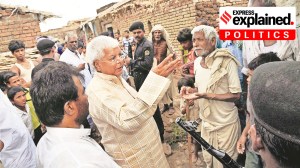The guile to fight a guerilla
Wars of subversion are won and lost in the minds,' to paraphrase the timeless words of Frank Kitson, by far the greatest military writer on...

Wars of subversion are won and lost in the minds,’ to paraphrase the timeless words of Frank Kitson, by far the greatest military writer on insurgencies and low-intensity operations. There is something about counter-insurgency operations (CI-OPS) that makes a soldier out of a maverick. A professionally average soldier, just about getting along in the career stream, but with an unconventional bent of mind, will produce results quite out of keeping with his recorded career profile.
And that is on account of only one factor — an insurgency environment allows some to flourish, and some to fail. Those who have the bent of mind to think, plan and attempt the unconventional will thrive in CI-OPS. But those who do not have it in them, will fail miserably despite whatever their career graph and annual confidential reports may say about professional acumen and leadership.
This unwritten rule has prevailed in every military the world over and at whatever time of its development that Army has been exposed to aCI-OPS environment. It is little wonder that in such circumstances officers and men of the Special Forces luxuriate, out of proportion to their numbers and deployment. Aden, Vietnam, Afghanistan and recently Peru are all examples of this rule etched in stone.
The Special Forces flourish because their minds are in tune with the peculiar demands imposed by CI-OPS, where the ground rule is that to fight a guerilla fight like a guerilla.’ And to fight like a guerilla you must first have the mindset to do so, then the training, tasking and lastly the equipment which goes with that type of warfare. By no stretch of imagination can it be said that this is a Special Forces preserve, but they certainly have it in abundance. But it is also a fact that this frame of mind or attitude is, unfortunately, not readily available.
Some are born with it, others acquire it over time, but none can become one by simply following a conventional career in soldiering. There are then the other category of officers and men. Thosewho could well be tigers if given a conventional war situation. They would have all the dash and charisma required to lead their men in taking, say Zoji La, Haji Pir or even Quaied post. These actions required courage, grit and determination, with sufficient intelligence to know how the enemy was prepared.
But in a CI-OPS environment these are not the qualities much in demand. For low-intensity type of operations call for guile, shrewdness and a mind that can out-flank the insurgent simply within the space of the left-hemisphere. To once again paraphrase what Frank Kitson said 35 years ago, “CI-OPS are fought by out-cunning the militant.” And the out-cunning process takes months of drudgery, effort and diligence for the first result to appear. And when it appears, more follow. It is a process which takes enormous patience and hard work to put into motion. Unlike anything that is on offer from a conventional conflict. When, therefore, an officer with a conventional mind frame fails during CI-OPS, itaffects the morale of his unit or sub-unit.
The officer may be brilliant in professional terms, but lack that peculiarity required for command in a CI-OPS environment. His failure to understand the situation leads to tension, discipline and, as a last resort, running amok by some soldiers also lacking in those unconventional traits.
The unfortunate aspect of these episodes is that some soldiers have assumed them to be a trend. Any knowledge of ground conditions will lead one to believe that given the number of soldiers deployed, the decades that the Army has been in this CI-OPS business, incidents of running amok have been remarkably few. For retired officers to draw the wrong lessons from these conditions is understandable, but for Army Headquarters to react similarly is doubly unfortunate. Some incidents last year in some Rashtriya Rifles (RR) batalions, which should have remained causes of concern, became the reason to introduce drastic changes in the command profile.
That is unfortunate, forRashtriya Rifles is one of the few Indian success stories in the last decades. To understand what the RR units have achieved, simply imagine Indians from every corner of the country put together and given the responsibility of overseeing the security of a given area. Without any knowledge of their commanders and buddies, soldiers in RR units have fought bravely and produced results that are remarkable by any stretch of imagination. When they are well led, RR units have performed superlatively.
Their record is worth admiring, and not denigrating on account of some incidents of running amok. Those incidents were caused by command problems, and compounded by the inability of the military secretary’s (MS) branch to identify the right type of commanding officer for an RR unit. The decision to restrict the top two unit appointments to only officers from fixed regiments is unfortunate. Similarly, to restrict the intake of soldiers to fixed regiments is also short-sighted.
For RR units have been performingexceptionally even when the soldiers where drawn from all arms and services, and officers as well. The problems developed when the MS branch started fudging on postings to RR, like it had done with Assam Rifles earlier. If the best do not go for CI-OPS then the results are plain to the eye. It is a fallacy, and it goes against the ethos of the Army, to assume that officers of other arms and services cannot perform and provide leadership in CI-OPS. Nobody has the monopoly over guile.



- 01
- 02
- 03
- 04
- 05




























